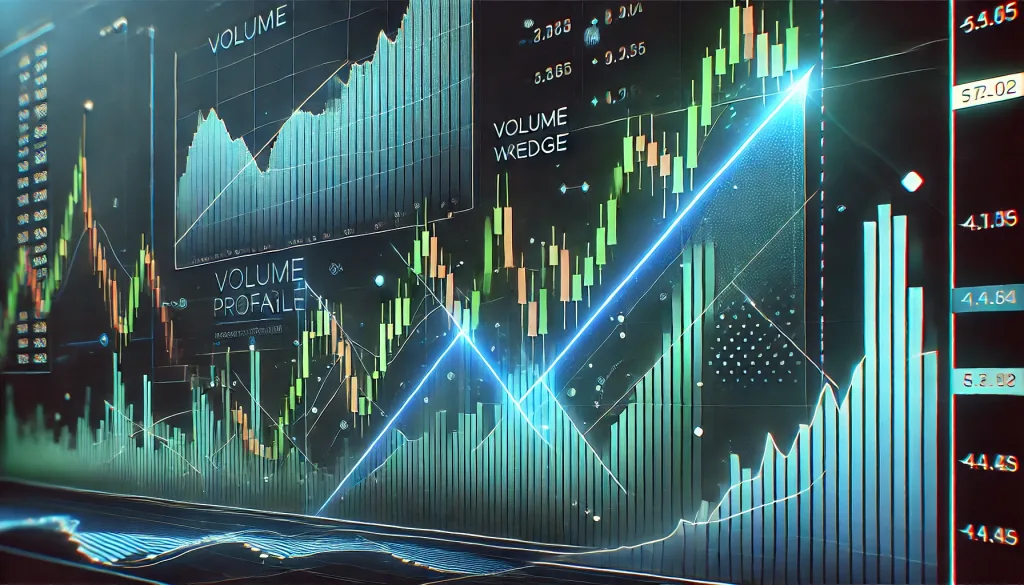The Hidden Trading Formula: Volume Profile & Rising Wedge for Pro-Level Market Predictions

Why Most Traders Get It Wrong (And How You Can Avoid It)
The Forex market is a beast. One moment, your trade is soaring like a SpaceX rocket; the next, it’s plummeting like your motivation on a Monday morning. If you’ve ever wondered why your technical analysis isn’t giving you an edge, it’s because you’re missing a critical piece of the puzzle: Volume Profile + Rising Wedge.
While most traders rely on surface-level indicators, pros dig deeper into market structure and liquidity. Volume Profile and the Rising Wedge are two of the most overlooked yet insanely powerful tools that separate the amateurs from the elite. But here’s the catch—most people misunderstand them.
What is Volume Profile (And Why It’s Your Best Friend)?
Volume Profile is like that friend who always knows the best restaurants—except instead of food, it tells you where the money is. This tool shows the traded volume at different price levels, highlighting key support and resistance zones.
Common Mistake: Most traders obsess over candlestick patterns but ignore volume. A bullish candle with low volume? That’s as unreliable as a weather forecast.
Why It Works: Volume Profile exposes hidden liquidity zones where big players (banks, hedge funds) accumulate or distribute positions. Knowing these zones means you can predict reversals and breakouts with sniper-like accuracy.
How to Read Volume Profile Like a Pro:
- Point of Control (POC) – The price level with the highest volume. This acts as a strong magnet for price action.
- High-Volume Nodes (HVN) – Areas of intense buying/selling interest. These levels offer great entries for trend continuations.
- Low-Volume Nodes (LVN) – Weak price areas where price moves quickly. These zones act as breakout triggers.
The Rising Wedge: The Trap That Most Traders Fall Into
If the market were a crime scene, the Rising Wedge would be the red flag that screams, “Danger! Trap ahead!”
A Rising Wedge is a bearish reversal pattern that occurs when price moves upwards within converging trendlines. It tricks traders into thinking the trend is bullish—but in reality, the momentum is weakening.
Why It’s Dangerous:
- The volume decreases as price rises—indicating a lack of real buying strength.
- The break below the wedge signals aggressive selling, causing rapid declines.
- Rookie traders see a bullish trend and buy. Smart traders wait for the breakdown and short.
The Winning Formula: Combining Volume Profile with the Rising Wedge
Here’s where the magic happens. Alone, Volume Profile and Rising Wedge are powerful, but together? They create a next-level forecasting tool that can predict price reversals before they happen.
Step-by-Step Strategy to Dominate the Market
- Identify the Rising Wedge – Look for an upward-sloping, narrowing price formation.
- Check Volume Profile – If price is near a High-Volume Node (HVN), it signals potential resistance.
- Watch for Declining Volume – If volume decreases while price rises, the move lacks strength.
- Wait for the Breakdown – A strong bearish candle breaking below the wedge confirms the reversal.
- Enter at Retest – Enter short when price retests the broken wedge support (now resistance).
- Target the Next Liquidity Zone – Set profit targets at Low-Volume Nodes (LVN) where price is likely to accelerate.
Real-World Example: How a Pro Trader Used This to Catch a 300-Pip Move
Let’s take EUR/USD as an example. In September 2023, a Rising Wedge formed near a key HVN on the Volume Profile. As price reached the top of the wedge, volume dried up—indicating weak buying pressure.
When price broke below the wedge support, smart money stepped in, triggering a 300-pip sell-off in just a few days. Traders who understood this correlation were able to capitalize on the move while others were left scratching their heads.
Advanced Tips & Ninja Tactics
- Look for Divergences: If RSI or MACD shows divergence while price is rising in a wedge, the reversal is even stronger.
- Combine with Order Flow Analysis: Track real-time order flow to confirm institutional activity at key levels.
- Use Smart Trading Tools: Leverage tools like the StarseedFX Smart Trading Tool for automated lot sizing and trade management.
Final Thoughts: The Trading Edge Most People Ignore
Mastering Volume Profile and Rising Wedge isn’t just about knowing what they are—it’s about understanding how to use them together to spot high-probability trade setups. By identifying hidden liquidity zones and pairing them with classic price action traps, you gain an unbeatable edge.
If you’re serious about leveling up your trading game, check out our Free Trading Plan and Community Membership to access elite strategies and real-time insights.
Image Credits: Cover image at the top is AI-generated
PLEASE NOTE: This is not trading advice. It is educational content. Markets are influenced by numerous factors, and their reactions can vary each time.

Anne Durrell & Mo
About the Author
Anne Durrell (aka Anne Abouzeid), a former teacher, has a unique talent for transforming complex Forex concepts into something easy, accessible, and even fun. With a blend of humor and in-depth market insight, Anne makes learning about Forex both enlightening and entertaining. She began her trading journey alongside her husband, Mohamed Abouzeid, and they have now been trading full-time for over 12 years.
Anne loves writing and sharing her expertise. For those new to trading, she provides a variety of free forex courses on StarseedFX. If you enjoy the content and want to support her work, consider joining The StarseedFX Community, where you will get daily market insights and trading alerts.
Share This Articles
Recent Articles
The GBP/NZD Magic Trick: How Genetic Algorithms Can Transform Your Forex Strategy
The British Pound-New Zealand Dollar: Genetic Algorithms and the Hidden Forces Shaping Currency Pairs
Chande Momentum Oscillator Hack for AUD/JPY
The Forgotten Momentum Trick That’s Quietly Dominating AUD/JPY Why Most Traders Miss the Signal
Bearish Market Hack HFT Firms Hope You’ll Never Learn
The One Bearish Market Hack High Frequency Traders Don't Want You to Know The

